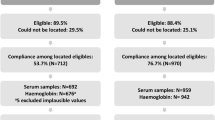Abstract
Background and aims: To investigate the prevalence of Helicobacter pylori (HP) infection, as well as possible risk factors affecting its acquisition among young Greek adults. Methodology: Sera were collected from 153 male young Hellenic Navy recruits (mean age 23.6 y.o.; range, 20–30 y.o.) at induction into the Hellenic Navy during January 1999. An enzyme-linked immunosorbent assay was used to detect HP-specific-IgG antibodies. All the subjects completed a structured questionnaire regarding demographic and socioeconomic data, as well as dietary habits, alcohol and tobacco use and gastrointestinal complaints. Statistical analysis was performed using logistic regression and the χ2 test. Results: The observed crude seropositivity rate was 19.01%. Among the examined parameters the most important predictive variable for HP-IgG status was the current median family income (B = +0.98, SEB = 0.56, p = 0.08, by logistic regression), which however, did not attain adequate statistical significance. The rate of seropositivity for HP that we observed is much lower than rates reported in older studies in this narrow-aged group in Greece. Probably the changes that ensued in life-style in Greece during the last 10 years resulted in a reduction in HP seropositivity.
Similar content being viewed by others
References
Taylor DN, Blaser MJ. The epidemiology of Helicobacter pylori infection. Epidemiol Rev 1991; 13: 42–59.
Sander JO, Veldhuyzen van Zanten, Pollak TP, Best LM, Benzanson GS, Marrie T. Increasing prevalence of Helicobacter pylori infection with age: Continuous Risk of infection in adults than Cohort Effect. J Inf Dis 1994; 169: 434–437.
Mitchell HM, Li YY, Hu PJ, et al. Epidemiology of Helicobacter pylori in Southern China: Identi.cation of Early Childhood as the Critical Period for Acquisition. J Inf Dis 1992; 166: 149–153.
Megraud F. Epidemiology of Helicobacter pylori infection. Gastroenterol Clin North America 1993; 22: 73–88.
Pateraki E, Mentis A, Spiliadis C, et al. Seroepidemiology of Helicobacter pylori infection in Greece. FEMS Microbiol Immunol 1990; 64: 129–136.
Broutet N, Gisbert JP, Pajares JM. The Year in Helicobacter pylori: Epidemiology. Curr Opin Gastroenterol 1999; 15(Suppl 1): S43–S48.
Feldman RA, James A, Eccersley P, Hardie JM. Epidemiology of Helicobacter pylori: Acquisition, transmission, population prevalence and disease-to-infection ratio. Brit Med Bull 1998; 54: 39–53.
Smoak BL, Kelley PW, Taylor DN. Seroprevalence of Helicobacter pylori infection in a Cohort of US Army Recruits. Am J Epidemiol 1994; 139: 513–519.
Rokkas Th. Helicobacter pylori: Current Aspects. Athens: ASTRA Hellas, 1998; 44–48.
Russo A, Ejoli M, Pizzetti P, et al. Determinants of Helicobacter pylori seroprevalence among Italian blood donors. Eur J Gastroen Hep 1999; 11: 867–873.
Brenner H, Rothenbacher D, Bode G, Adler G. Relation of smoking and alcohol and co.ee consumption to active Helicobacter pylori infection: Cross sectional study. Br Med J 1997; 315(7121): 1489–1492.
Zober A, Schilling D, Ott MG, Schauwecker P, Riemann JF, Messerer P. Helicobacter pylori infection: Prevalence and clinical relevance in a large company. J Occup Environ Med 1998; 40(7): 586–594. 13. Brenner H, Rothenbacher D, Bode G, Gommel R
Berg G, Adler G. Parental smoking and infection with Helicobacter pylori among preschool children in Southern Germany. Epidemiology 1998; 9(5): 545–549.
Mae FG. What are the factors that place an individual at risk for Helicobacter pylori-associated disease? Gastroenterology 1997; 113: S15–S20.
Staat MA, Kruszon-Moran D, McQuillan GM, Kaslow RA. A population based serologic survey of Helicobacter pylori infection in children and adolescents in the United States. J Infect Dis 1996; 174: 1120–1123.
Malaty HM, Graham DY, Wattigney WA, Srinivasan SR, Osato M, Berenson GS. Natural History of Helicobacter pylori infection in Childhood: 12-Year Followup Cohort Study in a Biracial Community. Clin Inf Dis 1999; 28: 279–282.
National Statistical Service of Greece. Country and city data book: Census 1977–1987–1997.
Author information
Authors and Affiliations
Rights and permissions
About this article
Cite this article
Kyriazanos, I.D., Ilias, I., Gizaris, V. et al. Seroepidemiology of Helicobacter pylori infection in hellenic navy recruits. Eur J Epidemiol 17, 501–504 (2001). https://doi.org/10.1023/A:1014580412253
Issue Date:
DOI: https://doi.org/10.1023/A:1014580412253




